Cactus vs Succulent: Unveiling 5 Succulents That Look Like Cactus
Are succulents and cacti interchangeable? Well, it’s like assuming all cats are tigers. Yes, all tigers are cats, but not all cats are tigers. Confusing, right? Don’t worry, we’re here to clear things up! In today’s post, we’re breaking down the cactus vs. succulent conundrum and showcasing some succulents that really know how to rock a cactus look. Get ready to dive into the world of prickly beauties and their sneaky doppelgängers!
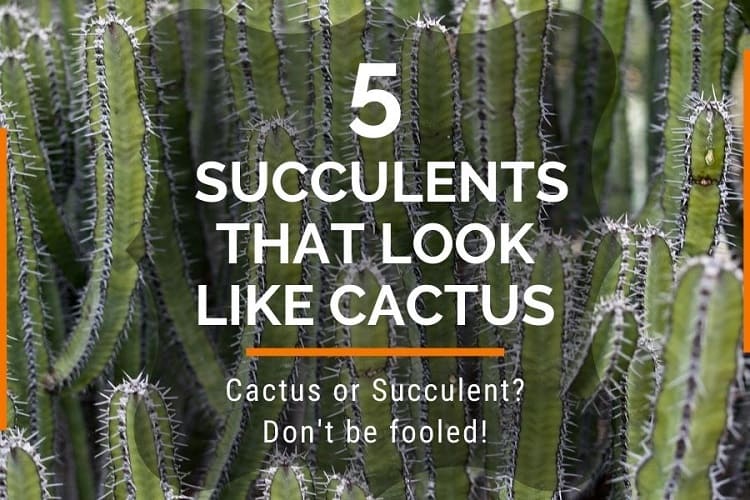
Contents
What is the Difference Between a Cactus and a Succulent?
Okay, let’s get down to the nitty-gritty of what makes cacti and succulents different from each other. The key player here is the “areole.” No, it’s not a fancy Hogwarts spell, but a round cushion-like structure that only cacti have. It’s like their special trademark. Think of it as their comfy pillow for spines to grow from. Succulents, on the other hand, don’t have these areoles. They missed out on the memo, I guess. And guess what? Unlike cacti that have their roots deep in American soil, succulents originate from the dry lands of Africa. They’ve got some serious travel envy going on.
Distinctive Features of Cacti
Now, let’s talk about the distinct features of cacti that make them stand out in a crowd. These spiky fellas are all about the thorny life. Their leaves? Well, they’re either nonexistent or just reduced to spines. Only two cactus species have the audacity to rock a full set of leaves. Talk about being rebels! Their stems are the real showstoppers, though. They proudly flaunt their plump and fleshy appearance, perfect for storing water. It’s like they’re saying, “Hey, rain, come at me! I’m ready!” And get this, their stems are shaped in a way that channels rainwater directly to their roots. Talk about being waterwise. These crafty cacti have roots that spread far and wide near the surface of the soil, making sure they absorb as much water as possible from a large area. It’s like a mini water harvesting system going on below ground.
Oh, and in the desert, you’ll often find cacti keeping their distance from each other, like socially distant plant buddies. But what really sets them apart are those special spots on their stems called “areoles.” These are like the VIP sections of the cactus club where sharp and rigid spines love to party. Some cacti even skip the spines and opt for funky hairs or sharp little beards called glochids on their areoles. Trust me, it’s a whole fashion show happening on those stems.
When it’s time to show off, cacti flowers are the stars of the show. They may be isolated little beauties, not playing the groupie game like other plants. Their flowers are usually large and eye-catching, without mixing with the crowd in inflorescences (fancy word for flower clusters). Instead of regular petals, they have these bracts or modified leaves that transform into sepals and eventually into mesmerizing petals. And boy, do they love to go all out on the stamens count! Plus, their fruit is usually shiny and fleshy, showing off some vibrant hues. Talk about being nature’s fashionistas.
5 Succulents that Look Like Cactus
Now, it’s time to unveil some sneaky succulents that give even the keenest plant lover a run for their money.
1. Euphorbia
First up, we have the Euphorbia. Look at the two plants below. One looks like a cactus, and the other? Well, it’s actually a spurge plant from the Euphorbiaceae family.
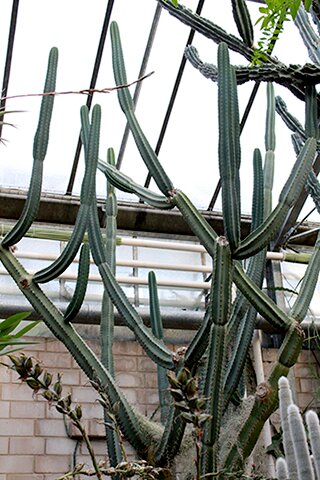
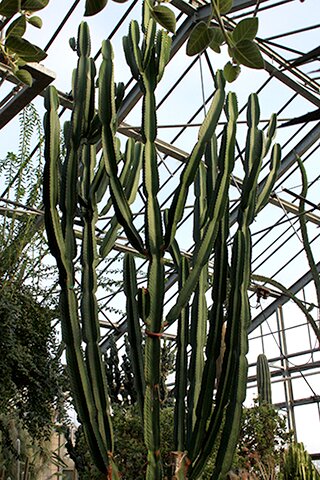
But wait, you’re probably wondering, “What’s the difference between these two look-alikes?” Let’s dig into it. First off, the place of origin reveals a major clue. While cacti are natives of the American continent, Euphorbias originally hail from the African continent. It’s like they took different paths in life and ended up in different neighborhoods.
Now, let’s talk flowers – nature’s way of revealing the truth. On the left picture below, we have the spurge plant with its interesting “flower” display. But here’s the twist: what appears to be a flower is actually an inflorescence. Those two large “petals”? Nope, they’re not petals at all. They are either transformed bracts or leaf-like appendages of nectar glands. The actual flowers are modest and uni-sexual, keeping a low profile. Sneaky, right?
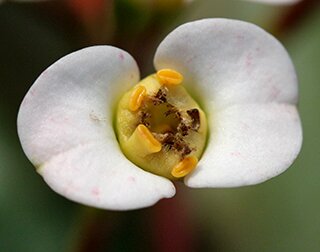
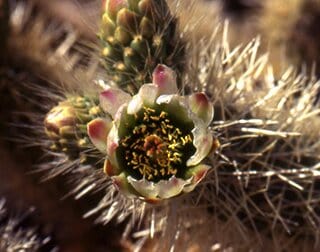
On the right, we have the cactus family, showing off their authentic flowers. These are the real deal, with genuine petals, stamens, and ovaries. They know how to make a grand entrance! Whether they’re radial symmetrical, funnel-shaped, or zygomorphic, cactus flowers don’t shy away from the spotlight. It’s like they were born ready to shine.
But what about those other distinguishing factors? Look closely at the pictures below, and you’ll notice that Euphorbias typically have a maximum of two thorns on their stems, often protruding from a shield-like structure. These thorns are usually converted stipules, giving them a unique appearance. On the other hand, cacti almost always sport three or more thorns that emerge from specialized areas called “areoles” – reduced short shoots. It’s like each plant has its own thorny style.
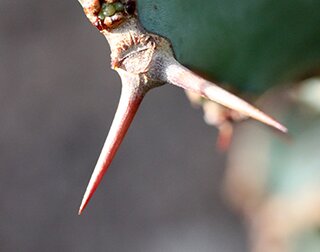

Here’s another fun fact: when you cut open a Euphorbia, a milky-white substance oozes out from the inside. It’s like a secret concoction they’ve got going on. But don’t be fooled by cacti either! Their insides contain a clear, watery liquid, except for a few rebel cacti in the Mammillaria genus that also have milky sap.
So, how can you tell them apart when they’re not flowering? A little poke might do the trick. If whitish juice squirts out, you’ve got a Euphorbia (the succulent impersonator). But be cautious, as the juice is toxic and can cause inflammation or even poisoning if you’re not careful.
Other Euphorbias that are often mistaken for cacti:
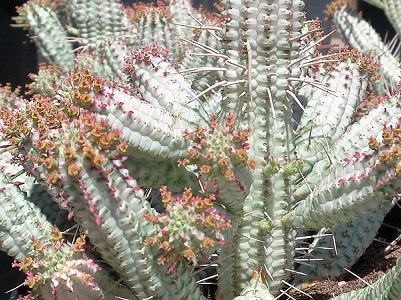
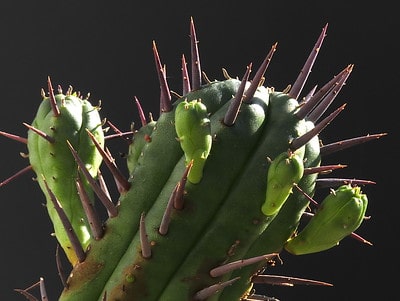
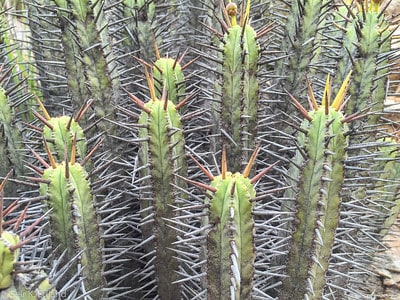
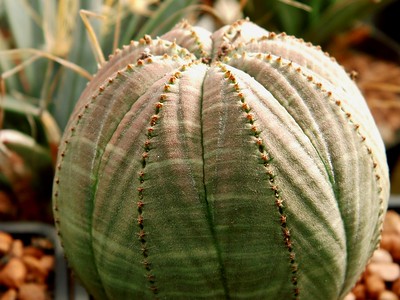
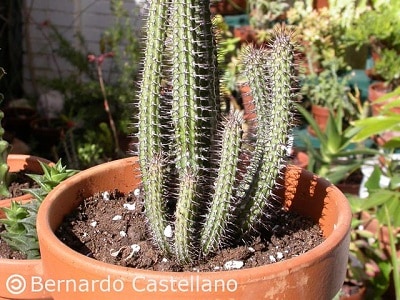
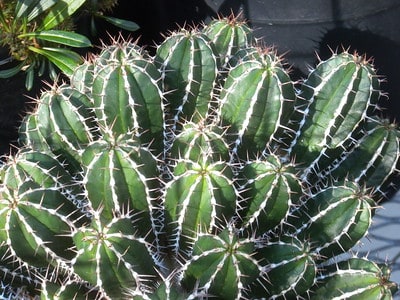
2. Pachypodium
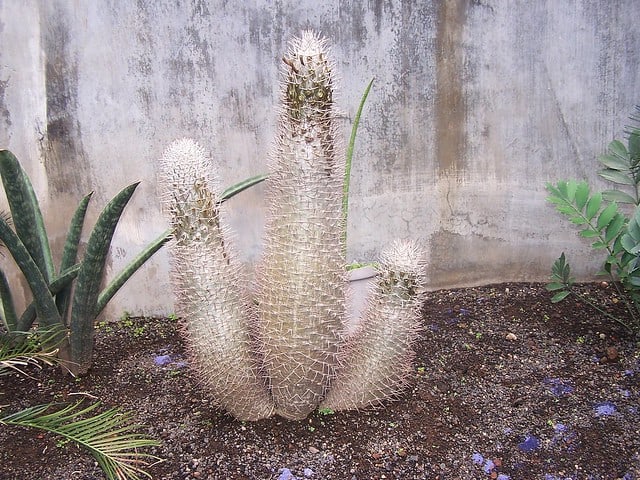
Prepare to meet the master of thorny illusion in the succulent world: Pachypodium. These magnificent plants, native to Madagascar and Africa, have mastered the art of resembling cacti, especially when they shed their leaves. They’ve got some serious style and deception going on!
One of the most striking features of Pachypodium is its spines. But here’s the twist – unlike most cacti that have spines growing from specialized areas called “areoles,” Pachypodium’s spines smoothly taper from the surface, without any interruptions. It’s like they effortlessly extend from the plant’s very skin, creating a seamless illusion of thorny glory. They’ve got the cactus look down pat!
When it comes to flowers, Pachypodium doesn’t disappoint. These plants can boast large and colorful blooms, adding a touch of elegance to their thorny appearance. But here’s something intriguing – unlike cacti, Pachypodium often possesses large, non-succulent leaves. It’s like they’re breaking the mold of typical succulent foliage and saying, “I’ll have some leaves, please!”
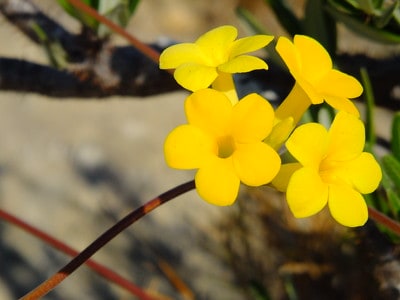
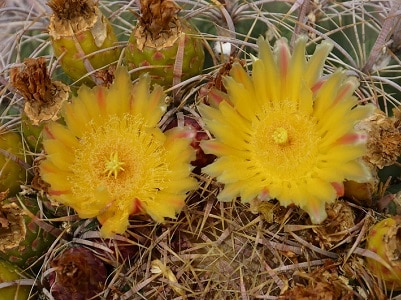
So, the next time you come across a Pachypodium and think, “Wow, that must be one impressive cactus,” take a closer look. Admire its thorny stems that seamlessly blend into the plant’s surface and marvel at its stunning flowers. Pachypodium may not be a cactus, but it sure knows how to pull off an awe-inspiring cactus impersonation. Nature sure loves to keep us on our toes!
3. Agave
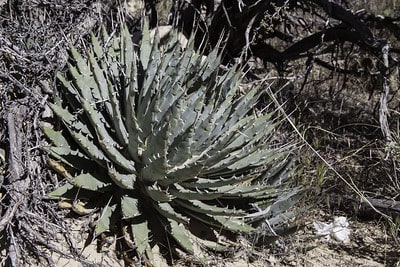

While some plant enthusiasts love classifying Agave as a cactus, the truth is that Agave has its own unique botanical classification. However, we can’t deny that Agave and cacti share several characteristics and environmental preferences. It’s like they’re distant cousins who enjoy the same desert vibes.
Let’s talk about flowering. Many cacti are notorious for their infrequent flowering, and Agave follows suit. While some Agave species may bloom after just a few years, others might take decades to show off their magnificent flowers. In fact, some Agave species have a once-in-a-lifetime flowering event. It’s like they’re playing hard to get, making their blooms all the more special and highly anticipated. Once they do flower, Agave plants often put on a spectacular show with their tall flower stalks and vibrant blossoms.
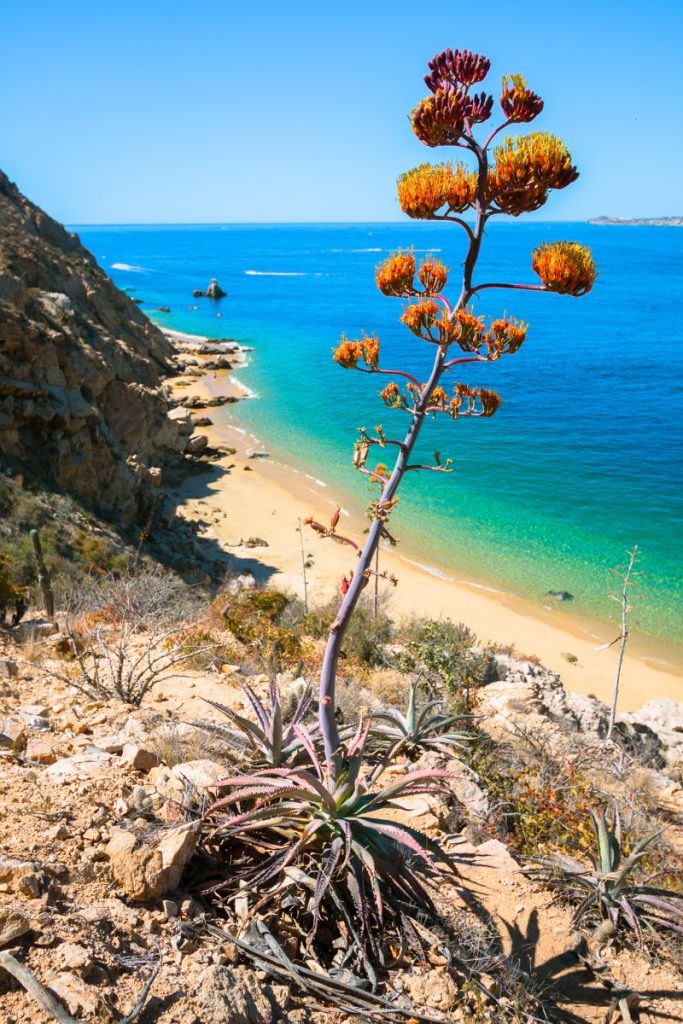
Similar to cacti, Agave thrives in arid climates and is often found in dry and rocky regions. These tough and resilient plants have adapted to store water in their fleshy leaves, making them perfect examples of leaf succulents. They have mastered the art of surviving long periods without water, allowing them to thrive in harsh conditions. It’s like they’ve become water-saving champions of the plant world.
4. Aloe
While Aloe and cacti may not be botanically related, they share many fascinating similarities. These resilient plants have captivated plant lovers with their thorny appearances and impressive water storage abilities. It’s like they’re wearing a cactus disguise while rocking their unique Aloe identity.
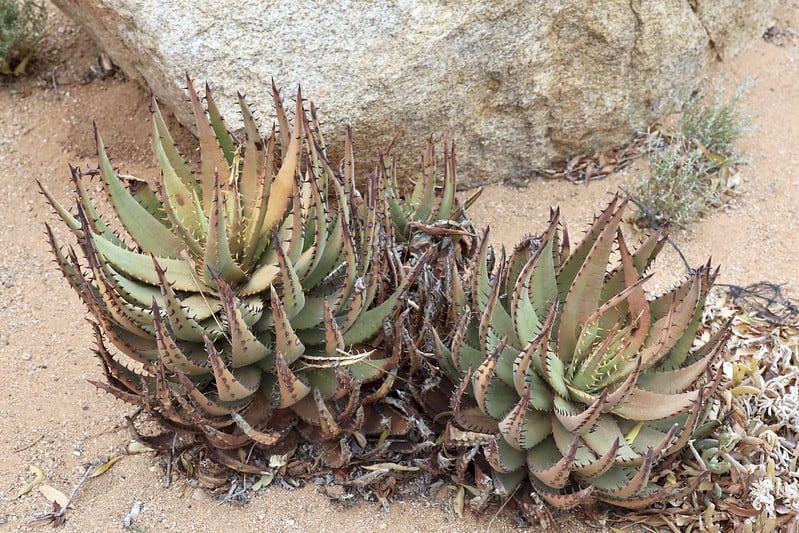
Let’s talk about their water storage skills. Just like cacti, Aloes are succulents, which means they have adapted to store water in their tissues. But here’s the intriguing part – while cacti store water primarily in their stems, Aloes have chosen a different path. They utilize their leaves as water storage organs, making them exceptional examples of leaf succulents. It’s like they’re saying, “Who needs those bulky stems when you can store water in stylish leaves?”
Although Aloes belong to their own family within the Asphodelaceae family, they often find themselves sharing similar terrains and tough climates with cacti. While wild Aloe species primarily inhabit deserts and rocky regions of Africa and offshore islands, cultivated Aloes, including the popular Aloe vera, can be found all around the world. It’s like they’ve become globe-trotters, spreading their succulent charm wherever they go.
Now, here’s an interesting tidbit: unlike certain Agave species that die after they flower, Aloes don’t follow the same playbook. Aloe plants are resilient beings, capable of surviving even after they’ve proudly displayed their vibrant blooms. It’s like they’re saying, “Who said flowering means the end? I’m here to stay!” So, cherish the beauty of their flowers and know that it’s not the end of their journey.
5. Stapeliads
Last but not least, we have the Stapeliads. These guys are the perfect example of look-alikes, even though they’re not closely related to cacti at all. It’s like they took a leaf out of the cactus’s book and said, “Hey, spines work for them, so let’s have them too!” These stem succulents have spines that give them that cactus-like appearance, but they’re a prime example of convergent evolution. It’s like nature’s version of twins separated at birth.
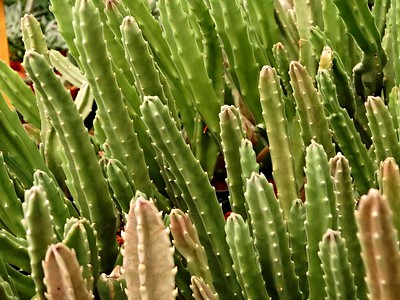
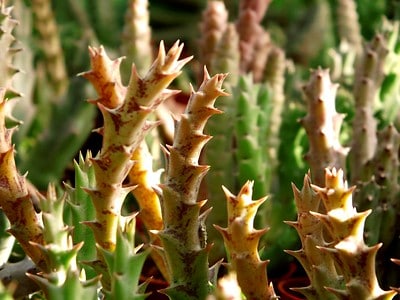
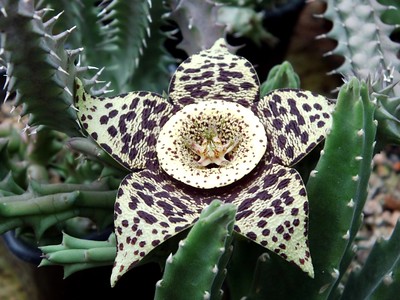
Although Stapeliads may look like cacti, they are an example of how plants can evolve in unique ways to adapt to their environments. Despite their thorny appearance, Stapeliads are not prickly as cacti. Their spines are similar in function, serving as a protective mechanism and deterring herbivores. But beyond the prickles, Stapeliads have their own distinct characteristics, making them a fascinating group of succulents to explore.
Now, let’s talk about flowers – the showstoppers of the plant world. Stapeliads have a surprising trick up their spiny sleeves. Many of their flowers bear a resemblance to rotting animal carcasses, earning them the intriguing nickname of “Carrion Flowers.” But don’t be grossed out just yet! Not all Stapeliads smell unpleasant or attract flies. Some species have evolved to exhibit beautiful and vibrant blooms without the unsavory odors. It’s nature’s way of playing with our senses and challenging our expectations.
In a Nutshell: Succulent vs Cactus
So, as we wrap up our exploration of the incredible succulent world, let’s take a moment to marvel at the fantastic plants like cactus. These succulents that rock the cactus disguise are a true testament to the wonders of convergent evolution, where different plant lineages adapt similar traits to thrive in the harsh, arid landscapes.
But here’s a little friendly reminder when it comes to identifying succulents: not all plants similar to cactus are the real prickly deal. Some succulents may flaunt spiky appearances or share certain features with cacti, but they actually belong to different botanical families. To become a true succulent sleuth, it’s essential to dig deeper into their unique characteristics and grasp those subtle differences. That way, you’ll conquer the art of accurately distinguishing between these sneaky succulent doppelgängers. Keep exploring and uncovering the secrets of the succulent world – nature’s disguise game is full of delightful surprises!
